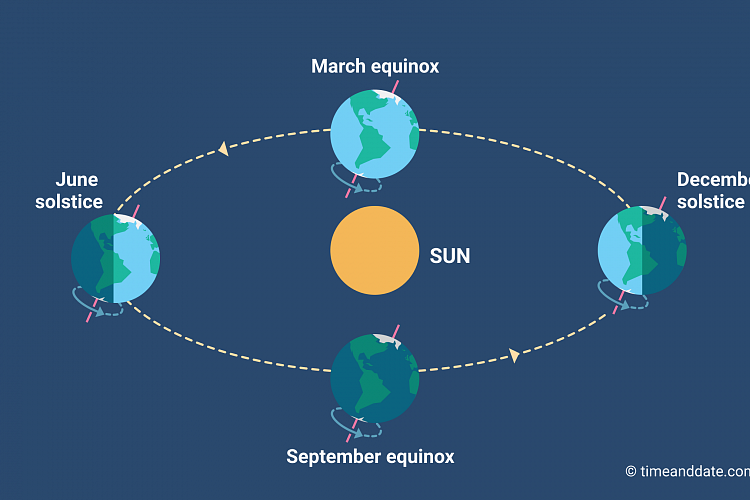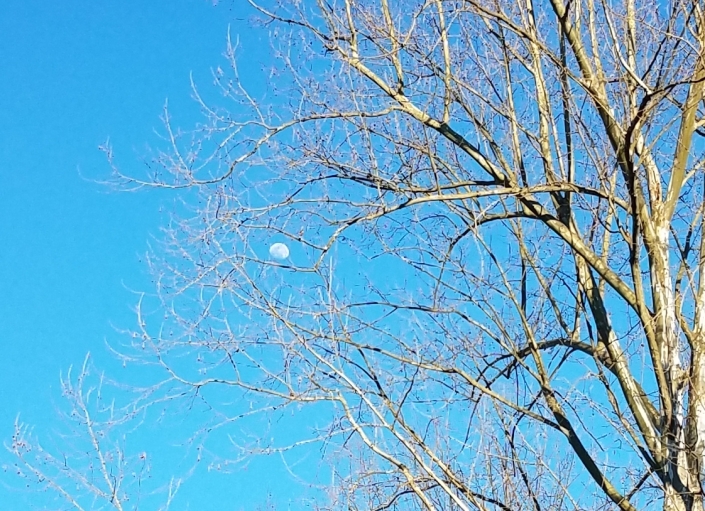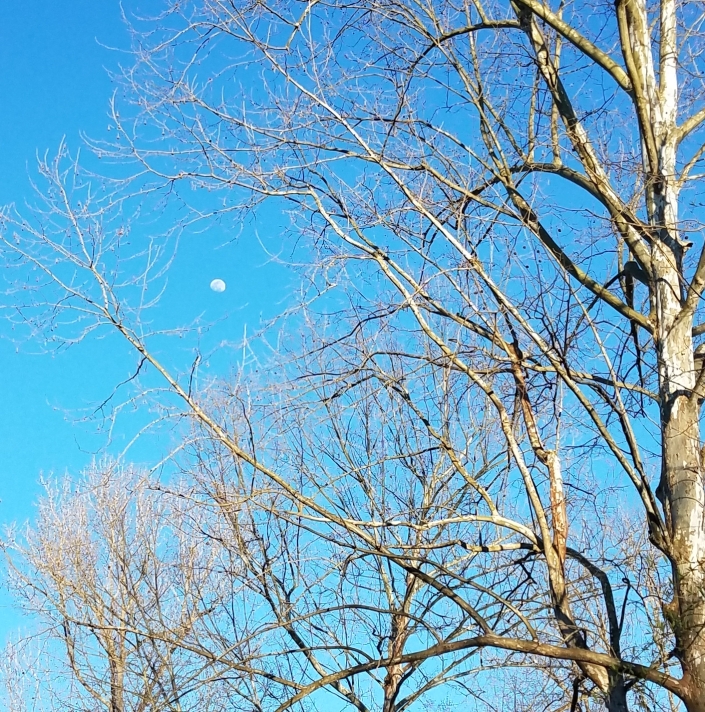Vernal Equinox & Worm Moon 2019

Spwing has spwung! Well, maybe not. I understand that the Northeast US is getting hit by a ‘Nor’easter‘ at the moment. But, as I am typing this, the official arrival time of the Vernal (Spring) Equinox was 5:58pm EDT here in the Northern Hemisphere/Southeastern US. I posted the definition of equinox back in September 2018 but, the term ‘Vernal’ translates to ‘new‘ or ‘fresh‘. A fresh start is on the way.
From Time And Date:
Earth’s axis is tilted at an angle of about 23.4° in relation to the ecliptic plane, the imaginary plane created by the Earth’s path around the Sun. On any other day of the year, either the Southern Hemisphere or the Northern Hemisphere tilts a little towards the Sun. But, on the two equinoxes, the tilt of the Earth’s axis is perpendicular to the Sun’s rays, like the illustration (below) shows. The March equinox is often used by astronomers to measure a tropical year, the mean time it takes for the Earth to complete a single orbit around the Sun. Also known as a solar year, a tropical year is approximately 365 days, 5 hours, 48 minutes and 45 seconds long.
Easter is celebrated on the Sunday following the first full moon on or after March 21. Since the full moon occurs on March 21 at 01:42 UTC, that, apparently, throws Easter’s celebrations to the Sunday following the next full moon, which is April 19.
There are other celebrations. From Time And Date:
The Iranian New Year (Nowruz, No-Ruz, No-Rooz or No Ruz) occurs during the time of the March Equinox, in accordance with the Persian astronomical calendar. It has been celebrated for over 3000 years and is rooted in the traditions of Zoroastrianism. No-Ruz celebrations last for about 12 days. Preparations start well in advance and include buying new clothes for family members and thoroughly cleaning homes. Wheat or lentil representing new growth is grown in a flat dish a few days before the New Year and is called Sabzeh (green shoots).
Higan (Higan-e or Ohigan), is a week of Buddhist services in Japan during the March and September Equinox. Both equinoxes have been national holidays since the Meiji period (1868-1912). “Higan” means the “other shore” (Sanzu River) and refers to dead spirits who reach Nirvana after crossing the river of existence. It celebrates the spiritual move from the world of suffering to the world of enlightenment.

We will also be graced with a full moon, tonight. It was 100% full illumination at 9:42pm EDT. Busy day! Unfortunately, we have had a rainy day, today, so no shots of it full. The sky has been nothing but a boring shade of grey. I did get a few shots of it earlier in the week, though. They weren’t too bad.

Peeking thru the limbs.
Saint Patrick’s Day

Looks like a golf ball.
Saint Patrick’s Day

Saint Patrick’s Day

Saint Patrick’s Day

Best I could do.
From Moon Giant:
March’s full moon is commonly called the Full Worm Moon. This is because of the earthworms that wriggle out of the ground as the earth begins to thaw in March. Here’s a little known fact about March’s full moon…it was called the Worm Moon only by Southern Native American tribes. In fact, there’s no way the Northern tribes would have ever called it the Worm Moon and the reason why is fascinating.
Essentially, earthworms did not exist in Northern America. It would be literally impossible for Northern tribes to see worms popping up in March. All the earthworms you see in Northern America today are invasive species brought in by colonists. These earthworms were brought over either out of a misguided intent to help fertilize the soil or, as an accident along with transported plants or the soil used for ballast in ships. Little did the colonists know that, during the last Ice Age, glaciers had spread so far across Canada and the northern parts of the United States that, all earthworms had been completely wiped out.
When the deep ice melted 12,000 years ago, the native forests in those areas grew back and adapted to the loss of earthworms. The growth of these forests became dependent on a layer of duff, which is a compost layer comprised of decomposing leaves and other rotting organic matter. If you ever visit one of these native forests, you will be asked to clean your shoes and make sure it’s free of earthworm eggs. That’s because, while it’s normally harmless everywhere else, earthworms will aggressively destroy the native forest’s duff layer by eating right through it.
This is why in Northern American tribes, such as the Shawnee tribe, the Worm Moon is called the Sap Moon, instead, as a reminder for the tribes that they can begin tapping maple syrup. In general, March’s full moon is known as a herald for the beginning of spring and new agricultural cycles. The Anglo-Saxons even used the Worm Moon as a way to predict the state of their crops. They called it the Storm Moon if it was stormy, which was a sign that their crops would fail. But, if it was dry, they called it the Rugged Moon, an indication of a bounteous harvest.
One of its other names is the Chaste Moon, symbolizing the purity of early spring. The Pueblo tribe named it the Moon When the Leaves Break Forth, while in Shoshone culture, it was known as the Warming Moon. Sometimes, it is called the Crow Moon, after the crows and other birds that appear as winter draws to a close. Other times, it’s called the Crust Moon, because of the snow that becomes crusty when it thaws in the sun and freezes in the moonlight.
In India, March’s full moon is also seen as a symbol of the arrival of spring and coincides with the festival of Holi. This is a riotous party where Indian communities all around the world engage in a huge water fight. Everyone goes out into the streets and sprays each other with colored water and powders, singing and dancing with strangers and, loved ones, alike. Playing and feasting together is a chance for you to repair relationships that have gone bad, reaffirming your existing social bonds as you move forward together into the new year.
Other moon names:
Moon When Eyes Are Sore From Bright Snow from the Dakota Sioux
Lenten Moon from the Christian settlers
Sugar Moon
Last Full Moon of Winter
It is also a Supermoon, our last for 2019.
Howl for me… ~Vic
March 20, 2019 at 11:47 PM
It was worth it just for the ‘Spwing has spwung!‘.
Good job.
LikeLike
March 21, 2019 at 12:48 AM
LOL! Thanks!
LikeLiked by 1 person
March 21, 2019 at 3:20 PM
Never realized there were so many phases of the moon…this one and the last post you had…I am happy Spring is here…
LikeLike
March 21, 2019 at 3:44 PM
Oh, yeah. New, first quarter, full, last quarter, waxing & waning, gibbous & crescent… Almanac’s have lunar planting schedules…still. Moon affects more than just tides. Ask ER docs or cops…people have moon fits…fight like hell.
LikeLiked by 1 person
March 21, 2019 at 3:49 PM
I have heard ER’s talk about it before. The gravational pull affects the tides… That I remember from school lol
LikeLiked by 1 person
March 22, 2019 at 8:19 PM
Welcome back spring. This is so interesting. I could look at the moon for hours.
LikeLike
March 22, 2019 at 8:35 PM
Meeeeee, too!
LikeLike
March 25, 2019 at 3:45 PM
Your photos are very well done! Happy Spring! Surely it is here, I sure hope so!
LikeLike
March 25, 2019 at 5:24 PM
I do the best I can with a Samsung stupidphone. You are too kind!
Happy Spring! I’m enjoying the flowers & the pair of Carolina Wrens nesting in my old wash tub. It hangs on a wooden fence & we always get a pair in there. Have watch those little critters…they will nest in the mailbox on the front porch if you don’t close the lid. 😄
🌷🌱🌳🌿🍀🥀🌼🌻🌹
LikeLiked by 1 person
March 26, 2019 at 11:25 AM
I wish we had Carolina Wrens they are sooooo cute. I need a different phone mine takes horrid photos.
LikeLike
March 26, 2019 at 4:36 PM
They aren’t much bigger than Hummingbirds and are hysterical. I get tickled listening to them when they ‘fuss’. They look like, to me, marshmallow peeps (shape)! 😄❤
LikeLiked by 1 person
March 26, 2019 at 5:21 PM
Lucky, Lucky You!!!
LikeLiked by 1 person